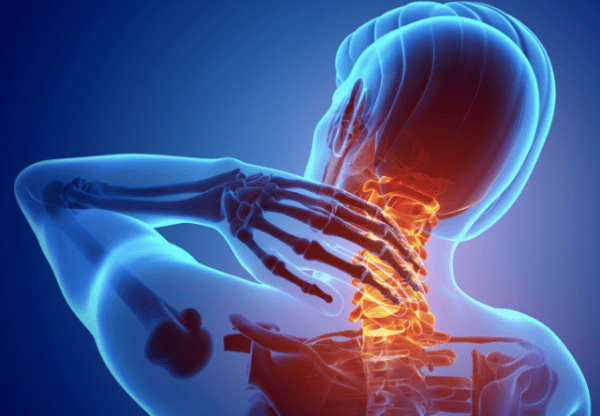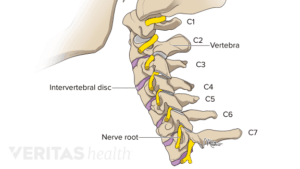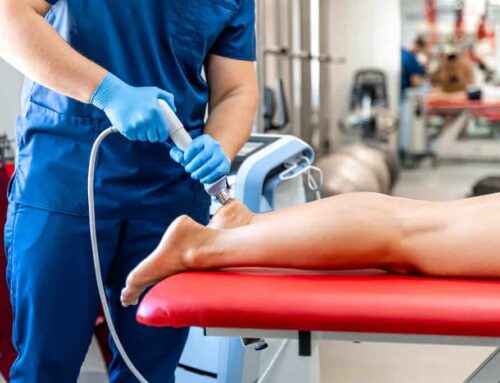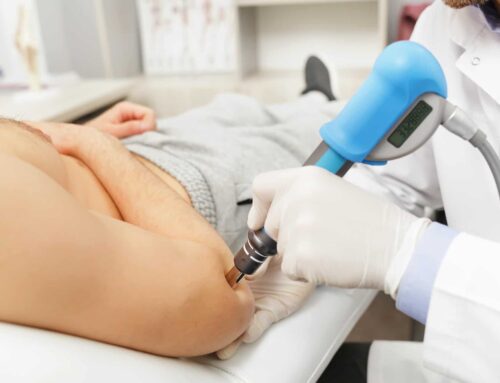Picture this: it’s Monday morning. You roll out of bed to find that you can barely turn your head to the right. When you try to force it, pain shoots down into your right hand. As you reach for your coffee mug, you notice your grip doesn’t feel as strong as it did yesterday. If this sounds like you, it’s possible you’ve got a case of cervical radiculopathy, or a pinched nerve in the neck.
**If you are experiencing severe pain, burning, numbness, tingling, and/or weakness in the arms and/or legs, seek help from a medical professional immediately. Though uncommon, these may be signs of a more serious issue.**
Read on to find out:
- What is cervical radiculopathy?
- What causes it?
- Will it get better?
- How can physical therapy help?
What is cervical radiculopathy?
The word cervical refers to the neck, and the word radiculopathy refers to injury or irritation of a nerve. Cervical radiculopathy is therefore another term for a pinched nerve in the neck. Since nerves travel out from the spine to each arm and leg, irritation at the neck can cause pain, numbness or tingling all the way to a hand or foot! In addition to pain, this condition may cause changes in sensation and weakness of muscles far away from the neck.
What causes cervical radiculopathy?
A few things could cause irritation of a nerve in the neck: disc material, bony changes of the spine, or both. The same things can cause irritation of a nerve in the low back. The nerves travel from the spinal cord out through small spaces between the bones. When something decreases that already small space, the nerve may become irritated.
Photo from: https://www.spine-health.com/conditions/neck-pain/chronic-neck-pain-what-condition-causing-my-neck-pain
I emphasize may because it’s very common for someone to have changes in discs and spinal joints without having any issues. In fact, studies have found that approximately 30% of 20-year-olds, and 60% of 50-year-olds, have disc bulges with absolutely no pain or restriction.
The point is: disc bulges and arthritis in the neck have the potential to pinch nerves and cause pain, but they do not always do this.
Will it get better?
Most likely, yes! In most people (more than ⅔) , conservative treatment is effective. Conservative treatment means anything but surgery – physical therapy, chiropractic, exercise, rest, medications, and more. The majority of people with this condition see great improvements in 4-6 months using a conservative approach.
How can physical therapy help?
Studies have shown that outcomes associated with physical therapy are as good as those associated with surgery in the management of this condition. Therefore it’s highly recommended to have a skilled physical therapist work with you prior to considering surgical intervention.
Helpful physical therapy treatments for cervical radiculopathy include hands-on techniques to the neck and mid-back, as well as exercises for the muscles of the neck and shoulders. Studies have shown that the combination of hands-on treatment plus strengthening is beneficial for improving both pain and function in those with a pinched nerve.
At DPT, we strive to determine the root cause of this condition – rather than just treating the symptoms, we also determine why it occurred in the first place and correct that in order to prevent it from happening again! Oftentimes, this comes down to the function of stabilizing muscles that surround and support the neck. When these aren’t working optimally, it can lead to muscular compensations that contribute to neck pain, arm pain, and headaches.
We’ve found the following exercises, among others, to be effective when combined with hands-on treatments for cervical radiculopathy.
If you’re dealing with something like this, it’s important to first seek assistance from a healthcare professional. We’d love to be of help – give us a call today so you can start getting back to the things you love.





